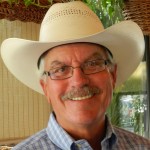
Sometimes Larry Byrd must think the water gods are tormenting him. Byrd began serving on the Modesto Irrigation District (MID) Board of Directors early in 2012, just in time to become embroiled in a contentious dispute about selling water to San Francisco. Byrd took an unpopular stand against the sale, then prevailed in an outcome that left a lasting bitterness among almost all the participants in an argument that hasn’t yet ended.
A long time MID employee (now retired) who also runs cattle and grows almonds on Stanislaus County’s east side, Byrd is the kind of person people call when they have a problem that requires real-world knowledge, willing hands, and a strong back. Several months ago, he began getting calls about a new kind of problem—one he couldn’t solve with his usual energy and tenacity.
“People’s wells were going out,” said Byrd recently, “especially along Lake and Crabtree Roads.”
Then, just a few weeks ago, Byrd’s own well ran dry. “That well was drilled in 1940,” said Byrd. “All of a sudden we had to go down another forty feet.”
Byrd wasn’t entirely surprised that wells on the county’s east side were going out. Like any one who works the land, he’s keenly attuned to changes in his surroundings. Some time ago he began worrying as thousands of acres of neighboring grasslands were converted to orchards.
While Byrd’s property is annexed into the MID and receives an allotment of surface water, he’s well aware that most of the orchards on the east side are dependent on groundwater. He also knows the Raker Act of 1913 prohibits the MID from annexing any more land. Since he’s spent a lifetime living and working in the arid east side, he’s familiar with traditional uses of the land and knows what happens when people try to operate against the laws of nature.
Lately, he’s been preoccupied with visions of the “cone of depression,” a hydrological feature that occurs when intense pumping begins drawing down the aquifer beyond the immediate vicinity of a pump. Byrd became especially alarmed when an MID employee told him the cone of depression on Stanislaus County’s east side is at twenty-five percent of the aquifer.
As he began considering solutions, he was struck by the wisdom of keeping MID water in the region. While the MID can’t annex any more land, there’s no law preventing the sale of water during wet years.
“Those orchards can’t survive without surface water,” says Byrd, “and the aquifer is dropping fast. It makes a lot more sense for the MID to sell water here in Stanislaus County than it does to sell water to San Francisco. If we sold water to east side farmers we’d get the economic benefits and we’d help recharge the aquifer.”
While selling water to Stanislaus County’s east side farmers does make a lot of sense, it will involve some hard analysis and choices. For one thing, some of the east side orchards have been planted on a thin layer of topsoil above a fractured rock subsurface. Fractured rock is one of the most inefficient of all grounds for infiltration of water. It wouldn’t help the aquifer much to spread water above fractured rock.
However, some of the new trees are planted on better soil, some of it close to the sandy loam type which is not only fertile but especially efficient with the infiltration of water. Those orchards could provide sustainable economic benefits to the entire region.
The economic advantages are worth plenty of hard analysis. Even without the new orchards, Stanislaus County agriculture produces well over $2 billion in product a year. The multiplier effect of this money in 2011 was estimated to amount to almost $9 billion.
When San Francisco offered $700 an acre foot for MID water, local officials and citizens were stunned at the amount. But the City of San Francisco has always known that the value of water has a multiplier effect almost beyond reckoning. In fact, the San Diego County Water Authority recently agreed to purchase 48,000 acre feet of water from a Carlsbad desalinization plant at a whopping $2,000 an acre foot.
Larry Byrd is keenly aware that in California, the value of water is increasing almost daily. He’s always seen the wisdom of keeping this priceless resource close to home, and now, more than ever, he’s operating under a compelling sense of urgency.
The water gods may be up to their usual games of torture and torment, but Larry Byrd is used to dealing with adversity—it’s the common lot of cattlemen and farmers everywhere. If there’s a way to bring much-needed water to eastern Stanislaus County, Byrd will find it, but he’d better work fast—it’s only a matter of time before another well runs dry.

Is selling water to east side farmers on the agenda for OID and MID?
OID has an agreement to provide water for Trinitas, a large, east side grower. The deal needs LAFCo approval, and the general feeling is it will be approved. That’s the only agreement so far. MID will only have water in wet years.
The well water problem of eastern Stanislaus County is similar to one in Madera County.
Dennis Smith owns a ranchette in an unincorporated urban area along Avenue 12 three miles west of State Route 41. His well ran dry, so he had to drill it down another 40 feet. At the rate the aquifer is dropping, his well could run dry again in as little as 5 years.
Urban and agricultural development in the Great Valley is using water at a rate that is not sustainable because much of the Sierra Nevada water is pumped through it to coastal communities. The only way to head off future shortages is to require coastal communities to use desalinization plant water such as the one built in Oceanside. The alternative is abandoned communities and farm land when the water runs out.